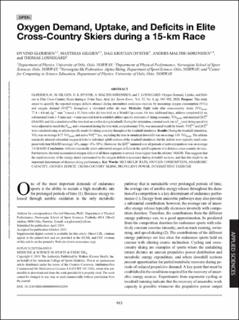Oxygen demand, uptake, and deficits in elite cross-country skiers during a 15-km race
Gløersen, Øyvind Nøstdahl; Gilgien, Matthias; Dysthe, Dag Kristian; Malthe-Sørenssen, Anders; Losnegard, Thomas Johansen
Peer reviewed, Journal article
Published version
Permanent lenke
https://hdl.handle.net/11250/2655386Utgivelsesdato
2020Metadata
Vis full innførselSamlinger
- Artikler / Articles [2119]
- Publikasjoner fra Cristin [1107]
Originalversjon
Medicine & Science in Sports & Exercise. 2020, 52(4), 983-992. 10.1249/MSS.0000000000002209Sammendrag
Purpose: This study aimed to quantify the repeated oxygen deficits attained during intermittent endurance exercise by measuring oxygen consumption (V˙O2) and oxygen demand (V˙O2dem) throughout a simulated roller ski race.
Methods: Eight male elite cross-country skiers (V˙O2peak, 77.4 ± 4.4 mL·kg−1⋅min−1) raced a 13.5-km roller ski time trial on a World Cup course. On two additional days, athletes completed (i) six submaximal loads (~5 min) and ~4-min maximal trial to establish athlete-specific estimates of skiing economy, V˙O2peak, and maximal ΣO2def (MAOD); and (ii) a simulation of the time trial on a roller skiing treadmill. During the simulation, external work rate (Pprop) and skiing speed (v) were adjusted to match the Pprop and v measured during the time trial, and pulmonary V˙O2 was measured breath by breath. V˙O2dem and ΣO2def were calculated using an athlete-specific model for skiing economy throughout the treadmill simulation.
Results: During the treadmill simulation, V˙O2 was on average 0.77 V˙O2peak, and active V˙O2dem (i.e., excluding the time in simulated downhill) was on average 1.01 V˙O2peak. The athletes repeatedly attained substantial oxygen deficits in individual uphill sections of the treadmill simulation, but the deficits were typically small compared with their MAOD (average 14%, range ~0%–50%). However, the ΣO2def summed over all periods of active propulsion was on average 3.8 MAOD.
Conclusion: Athletes repeatedly attain substantial oxygen deficits in the uphill segments of a distance cross-country ski race. Furthermore, the total accumulated oxygen deficit of all these segments is several times higher than the athletes’ MAOD. This suggests that the rapid recovery of the energy stores represented by the oxygen deficit is necessary during downhill sections, and that this might be an important determinant of distance skiing performance.
Beskrivelse
This is an open-access article distributed under the terms of the Creative Commons Attribution-Non Commercial-No Derivatives License 4.0 (CCBY-NCND), where it is permissible to download and share the work provided it is properly cited. The work cannot be changed in any way or used commercially without permission from the journal.
